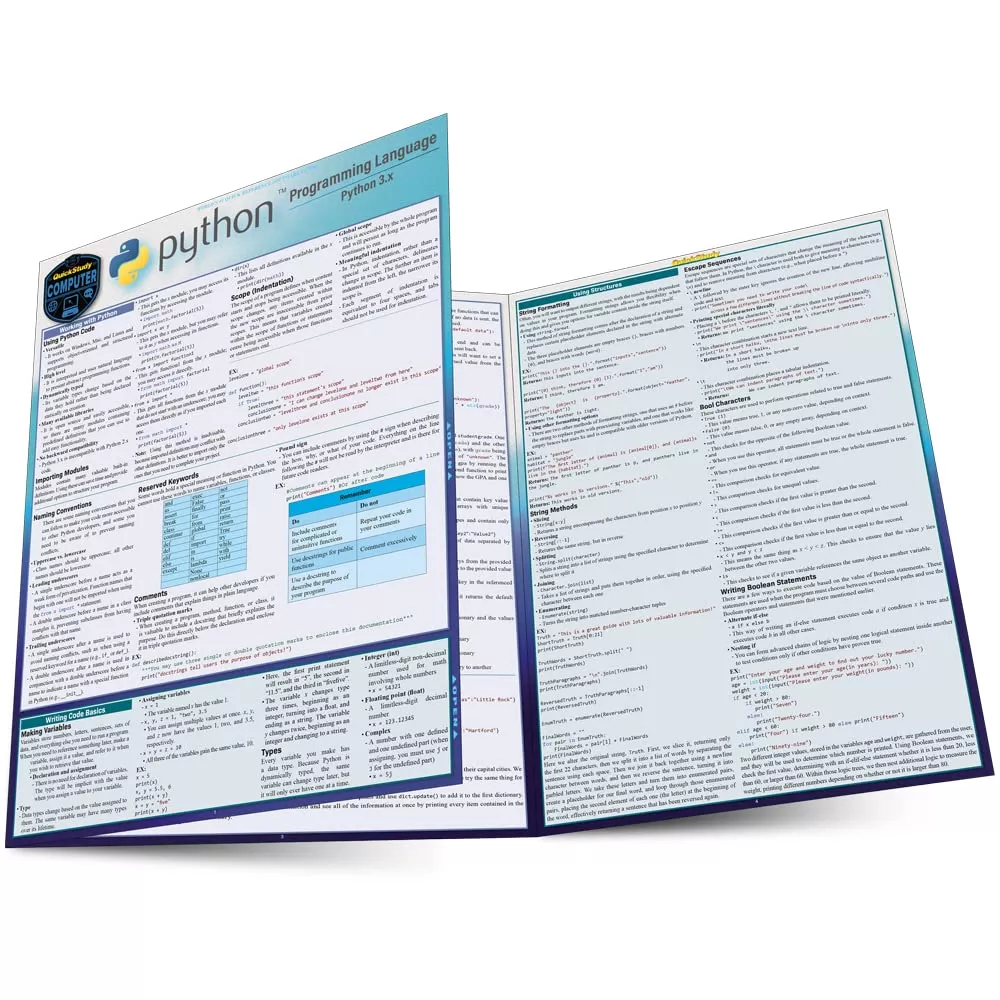
The Python Programming Language QuickStudy Laminated Reference Guide is an essential tool for developers at all skill levels. This article delves into its features, benefits, and how it serves as an effective reference for mastering Python programming.
Product Features
| Feature | Description |
|---|---|
| Manufacturer | Berajah Jayne |
| Type | Laminated Reference Guide |
| Pages | 6 |
| Topics Covered | Python syntax, logic, error handling, classes, and much more |
| Size | Handy desktop reference |
| Target Audience | Beginner and seasoned programmers |
Product Overview
| Pros | Cons |
|---|---|
| Compact and easy to use | May not cover advanced topics |
| Concise reference for quick look-ups | Limited to Python basics |
| Ideal for all skill levels | Laminated guide may wear over time |
Overview of Python Programming Language
As I dive into the nuances of utilizing the QuickStudy Laminated Reference Guide for Python, I find it instrumental in navigating the intricacies of this versatile language. First, let’s focus on the section dedicated to **working with Python code**. It’s designed to provide a quick refresher on syntax and structure, helping you avoid common pitfalls as you write your scripts. I often rely on these snippets to ensure I’m adhering to best practices, especially when tackling challenges that arise in day-to-day programming.
Next, **importing modules** is a crucial aspect that I frequently reference. The guide succinctly breaks down how to leverage Python’s vast library ecosystem, enabling me to enhance my applications without reinventing the wheel. I appreciate the clear examples, as they help to simplify what could otherwise be a daunting process, allowing me to focus more on functionalities rather than the technicalities.
Additionally, understanding **coding structures** is vital for any programmer, especially beginners. The guide highlights important concepts like loops, conditionals, and data structures, which are essential for forming the backbone of robust applications. Each section of the guide acts as a stepping stone, providing clarity and confidence as I code.
By incorporating the QuickStudy guide into my learning routine, I not only grasp the fundamentals more quickly but also apply them effectively in real-world scenarios. The hands-on approach this reference provides transforms complex topics into digestible chunks, making Python programming a more enjoyable and accessible journey.
Using the QuickStudy Reference Guide Effectively
When it comes to making the most of the Python Programming Language QuickStudy Laminated Reference Guide, I find that familiarity with its layout and content is fundamentally crucial. The guide is perfect for both novice programmers and seasoned developers who need quick access to essential information. I quickly navigate the section on **Python code**, where you can find examples of syntax, functions, and data types, all in a condensed format. This quick glance helps me recall how to structure code efficiently, especially under tight deadlines.
Next, I appreciate the section dedicated to **importing modules**. Understanding how to leverage Python’s extensive libraries is a game-changer. With the guide at hand, I can easily reference how to import libraries like NumPy or Pandas, which I often use for data manipulation tasks. The step-by-step examples paint a clear picture, ensuring that I don’t get lost in the intricacies of module management.
Additionally, I consistently refer to the coding structure outlines, such as loops and conditional statements. Having these organized neatly allows me to avoid common pitfalls. I often find myself in situations where a quick reminder of syntax can save time during debugging. Overall, incorporating this laminated guide into my daily programming workflow not only enhances my coding skills but also improves productivity. Using it effectively means keeping it visible on my desk for easy access during coding sprints, and soon, it becomes an intuitive part of my programming routine.
Conclusions
In conclusion, the Python Programming Language QuickStudy Laminated Reference Guide is a practical tool for both novice and experienced programmers. Its concise format and essential information make it a valuable addition to anyone’s programming resources. Whether you’re troubleshooting or learning new concepts, this guide has got you covered.